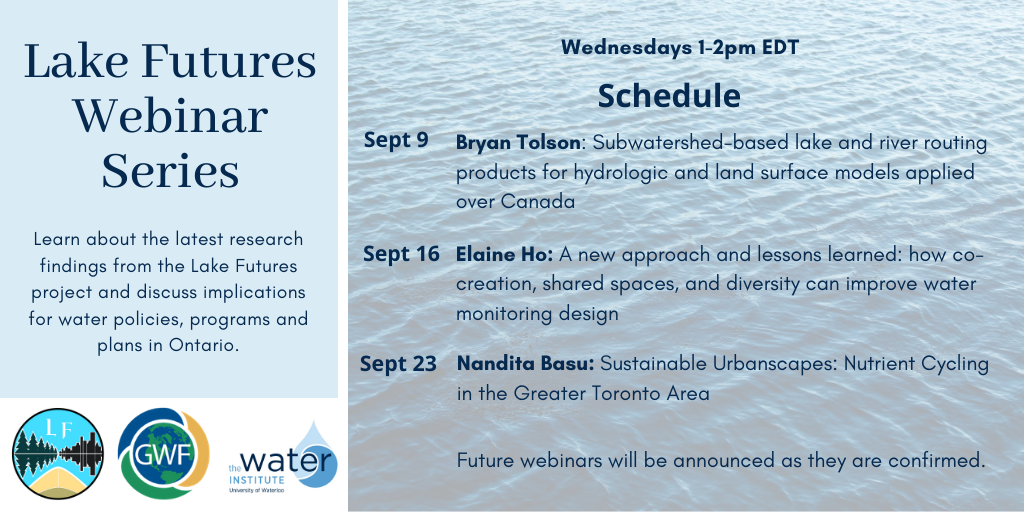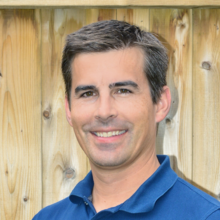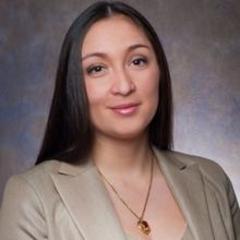
The Lake Futures team is excited to present the next installment of our webinar series. This series is an opportunity for the academic and non-academic community to engage with Lake Futures researchers, as they share their latest research findings and discuss implications for water policies, programs, and plans in Ontario.
Webinars will be offered weekly, on Wednesdays from 1-2pm EDT. Webinars will include a 30-minute presentation, followed by a 30-minute discussion period. Recordings of webinars will be made available. Join the conversation, register today!
Upcoming Webinars
| Date and Time | Speaker | Description |
|---|---|---|
|
Sept 9 1-2 pm EDT |
 Bryan Tolson, Professor in Civil and Environmental Engineering |
Subwatershed-based lake and river routing products for hydrologic and land surface models applied over CanadaLakes and reservoirs have important impacts on hydrological and biogeochemical functions of a landscape but are often overlooked in regional hydrological models. This is important in Canada where we have a huge number of lakes. In this webinar, Bryan Tolson, will share recent work of Han et al. (2020) deriving a suite of Pan-Canadian subwatershed-based lake and river routing GIS products at multiple spatial resolutions. These publicly available data products supply all the necessary hydrologic routing model inputs. All Water Survey of Canada streamflow gauging stations are used to define subwatershed outlets in the products. The routing product is used to inform a hydrologic routing model in the Raven hydrologic modelling framework, and is the first demonstration of Raven in routing-only mode. The Hudson Bay drainage basin (40% of Canada), including more than 20,000 river reaches and 10,000 lakes, will be simulated as a case study. A corresponding GIS lake and river routing toolbox under development will also be highlighted that puts the watershed and lake discretization decisions into the modeller’s hands instead of relying solely on the small set of products in Han et al. (2020). |
|
Sept 16 1-2 pm EDT |
 Elaine Ho, PhD Candidate, Social and Ecological Sustainability (Water), School of Environment, Resources and Sustainability |
A new approach and lessons learned: how co-creation, shared spaces, and diversity can improve water monitoring designWhen designing conventional water monitoring programs, the design process is focused on establishing the right monitoring parameters, methodologies, and schedules. Community values are not usually considered and there is limited coordination with decision-makers. Therefore, these programs often fail to consider how the results will inform management decisions or meet the needs of the local community. In this presentation, Elaine proposes a new way of developing monitoring programs that consider cumulative effects, are co-created by diverse stakeholders, and connect monitoring to broader river or lake management decisions. The lower Grand River and nearshore Lake Erie was the focus of her research, and the new monitoring framework that emerged is used a case study for discussion. Elaine will share lessons learned throughout this process, highlighting benefits of community and Indigenous engagement and how to overcome associated challenges. |
|
Sept 23 1-2 pm EDT |
 Nandita Basu, PI of Lake Futures,Associate Professor in Civil and Environmental Engineering and Earth and Environmental Sciences, Director of the Collaborative Water Program |
Sustainable Urbanscapes: Nutrient Cycling in the Greater Toronto AreaIncreasingly, humans in the developed world are living in cities. These urban centres disrupt nutrient cycles by importing large quantities of food, and exporting waste to nearby water bodies. Investigating flows of nutrients in urban centres can help to identify opportunities to increase food security and reduce freshwater pollution. Join Nandita Basu, as she shares the latest research on nutrient budgets for nitrogen and phosphorus in the Greater Toronto Area. Learn about impacts urban centers have on their surrounding environment, and opportunities to build a more circular economy. |
Recordings of previous webinars in this series are available.